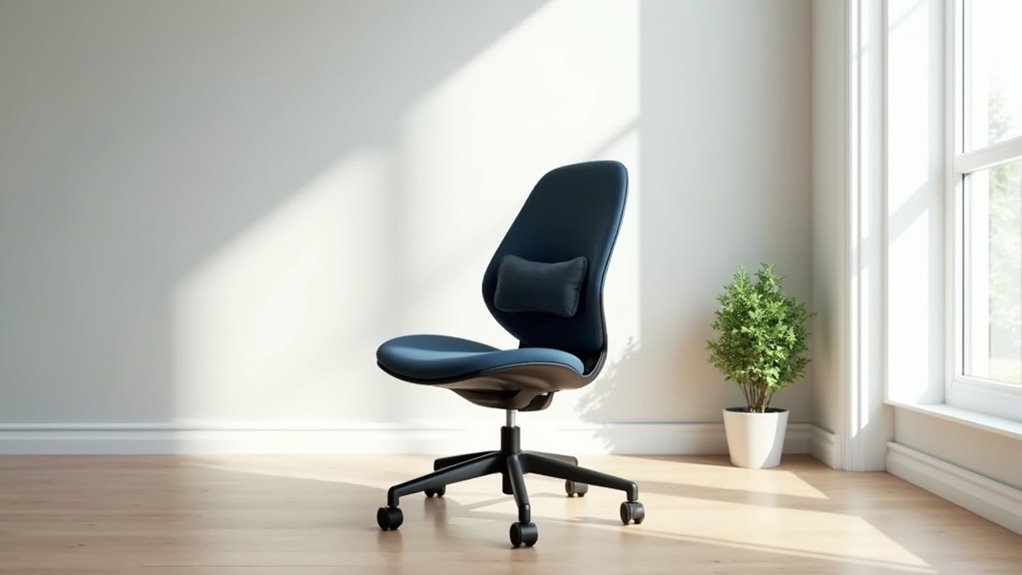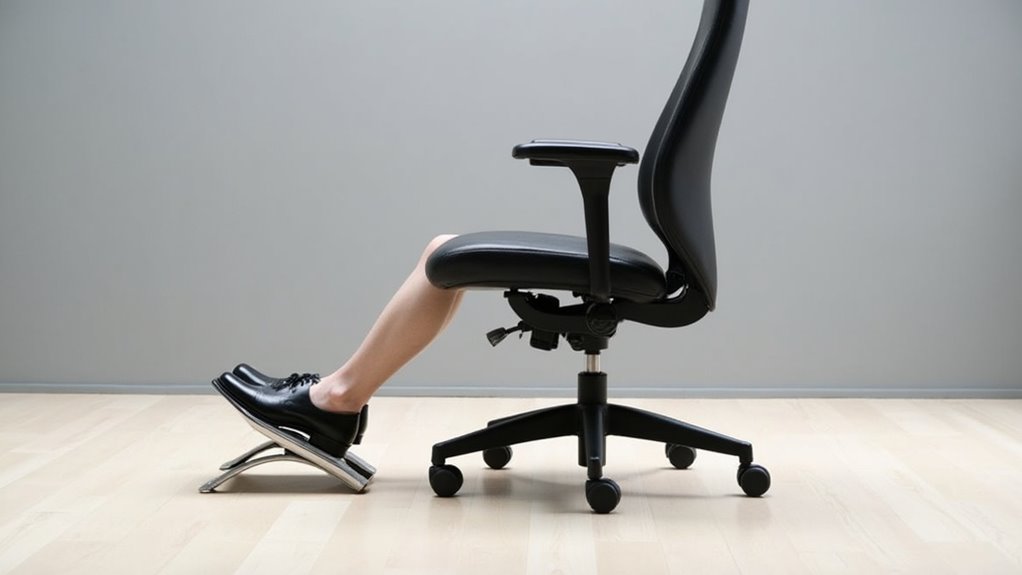How to Sit in a Chair Correctly
This post contains affiliate links. As an Amazon Associate, we earn from qualifying purchases.
To sit correctly in a chair, adjust your chair height so your feet are flat on the floor and your knees are at a 90-degree angle. Keep your back straight against the chair for support, and ensure your elbows are bent comfortably close to your sides. Avoid crossing your legs to prevent numbness. Additional details and tips will follow for those looking to enhance their sitting posture further.
Essential Facts in 30 Seconds
- Adjust seat height for flat feet and 90-degree knees.
- Sit up straight with back against the chair; use lumbar support.
- Keep elbows bent at 90 degrees; forearms flat on the desk.
- Maintain a neutral spine; align head with neck and shoulders.
- Do not cross legs; keep feet flat or use a footrest.
Chair and Seat Adjustment for Proper Sitting
Sitting in a chair should be comfortable and good for your health. Start by adjusting your seat height. Your feet should rest flat on the floor. This position gives you stability. Keep your knees at a 90-degree angle, level with your hips. Additionally, ensure that your chair height allows for elbows resting comfortably at your sides, which helps to prevent shoulder strain.
To achieve the right chair height, pull the lever while sitting down to make the adjustment easier. Can’t reach the floor? Use a footrest. This keeps your thighs parallel to the ground. Proper circulation is essential for preventing discomfort during long periods of sitting. Now, check the seat depth. There should be about two fingers’ width between the seat edge and the back of your knees. This space helps blood flow and avoids pinching. Make sure the seat supports most of your thighs without pressing into your knees.
With these simple adjustments, you’ll feel great and ready to take on the day!
Back Support and Spine Alignment

Now that your chair is adjusted, let’s discuss back support and spine alignment. Keeping your spine healthy is very important. Sit up straight and let your back rest against the chair. Use lumbar cushions or a rolled towel if your chair lacks built-in support. This will help your lower back keep its natural curve. Your back will appreciate it!
Keep your head and neck in line with your spine. Don’t lean forward, as this can cause tension. Hips and knees should be level, with thighs parallel to the floor. This helps distribute your weight evenly. Proper sitting techniques can alleviate strain on the lower back, preventing discomfort over time. Correct sitting posture is essential for maintaining overall health, as it significantly reduces strain on your back, neck, and shoulders. Poor posture can exacerbate muscle imbalances, leading to increased discomfort over time. Proper sitting posture is essential for maintaining overall health.
Take breaks to stretch and move around. Sitting for long periods can lead to discomfort.
A happy spine means more comfort. A comfy back helps you focus on what you love to do!
Arm and Shoulder Positioning
Getting your arms and shoulders in the right position makes sitting at your desk much better. Proper positioning helps your arms move easily and keeps your shoulders relaxed. Here’s how to achieve this:
- Bend your elbows at about 90 degrees and keep them close to your body.
- Let your forearms rest flat on the desk. This prevents awkward wrist angles.
- Keep your shoulders relaxed. Don’t let them hunch up.
- Avoid reaching too far forward. Your arms should hang comfortably by your sides.
- Make sure there’s enough space for your arms to move freely. Proper arm positioning can also help maintain a neutral spine, reducing strain on your back over long periods. Additionally, ensuring that your chair height is appropriately adjusted can significantly enhance your overall comfort while working. This can be particularly beneficial for maximizing comfort, which contributes to better focus and efficiency. Regular adjustments to your chair can also promote better posture, further enhancing your comfort throughout the day.
These simple tips can improve your comfort and focus while working.
Leg and Foot Positioning

Proper leg and foot positioning can greatly improve your comfort while sitting. Here’s a simple guide to help you align your legs and feet correctly:
| Tip | Details |
|---|---|
| Feet Flat on Surface | Keep feet flat on the floor for stability. |
| Knee Angle | Aim for a 90-degree angle at your knees. |
| Avoid Crossing Legs | Crossing legs can block blood flow. |
| Use a Footrest | A footrest can help if you can’t reach the floor. |
| Check Seat Depth | Make sure the seat depth fits your leg length. |
Following these tips can help prevent strain-related injuries and ensure a more comfortable sitting experience! Additionally, ensure that your chair height promotes correct chair height to maintain proper posture and prevent discomfort. Maintaining proper positioning also helps in reducing leg strain and encourages a natural spine curve.
Head and Neck Posture
Sitting in a chair can be comfortable. Good head and neck position helps a lot. Follow these easy tips for better neck alignment:
- Keep your ears above your shoulders.
- Sit up straight. Slouching puts strain on your neck.
- Adjust the headrest. It should support the back of your head, not your neck.
- Avoid leaning forward. Keep your head against the headrest.
- Check your posture often. Good habits make a difference!
Proper posture helps you feel better and reduces discomfort. Additionally, ensure that your chair has adequate lumbar support to maintain a healthy spine alignment.
Stay aware of how you sit to enjoy these benefits.
Frequently Asked Questions
How Often Should I Change My Sitting Position?
Change your sitting position every 20 to 30 minutes. This keeps you comfortable and healthy. Aim for about 16 different sitting positions during an 8-hour workday. Frequent posture changes help reduce stress on your body. It also improves focus and energy levels. Make it a habit to stand, stretch, or walk briefly. Small movements can make a big difference. Your body will thank you for it!
What Type of Chair Is Best for Prolonged Sitting?
Ergonomic chairs are the best choice for long hours of sitting. They have lumbar support that helps your back stay healthy. Good posture is important. It keeps you comfortable and focused.
These chairs reduce the risk of back pain and other health problems. Studies show that sitting in ergonomic chairs can improve productivity.
Look for features like adjustable height and armrests. These help you find the right fit. A comfortable chair can make a big difference in your day. Investing in a good chair is smart for your health and work.
Are Standing Desks a Good Alternative to Sitting?
Standing desks can change your work life for the better. They help with good posture and reduce back pain. Many people notice they feel more focused and productive. Standing while working can also give you more energy throughout the day.
Studies show that using a standing desk can decrease discomfort. This means fewer distractions and more engagement in your tasks. You might even find it easier to concentrate on your work.
How Can I Relieve Discomfort While Sitting?
Sitting for a long time can cause discomfort. Stretching exercises help ease tight muscles. Simple neck rolls and shoulder shrugs can make a big difference. Adjust your chair for better support. Keep your feet flat on the floor. Try to sit up straight.
Changing your position often is important. Stand up and walk around every hour. Take a few deep breaths to relax. Use a cushion for extra comfort. Remember to stay hydrated. Drink water throughout the day.
These small changes can keep you comfortable while sitting. Stay active and listen to your body.
Should I Use a Cushion for Additional Support?
Using a cushion for extra support is a smart choice. Cushions can help improve your posture. They also reduce discomfort while sitting. There are different types of cushions available. Dynamic cushions move with you. Lumbar cushions support your lower back. Both types promote spinal alignment. They relieve pressure on your body. This can make sitting much more comfortable. A good cushion can really enhance your sitting experience.
Conclusion
Sitting in a chair correctly helps your body feel good. Start by adjusting your chair to the right height. Your feet should touch the ground. Keep your back straight. Your arms should rest comfortably by your sides. They shouldn’t feel stiff or tense. Legs should be relaxed, not crossed.
Make sure your head is aligned with your spine. It should sit straight, not leaning forward or backward. Good posture can help prevent back pain and improve focus. You’ll feel more comfortable and ready to work. Remember, great posture is a simple way to stay healthy and feel good. Enjoy your time sitting!
